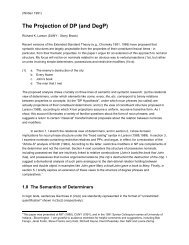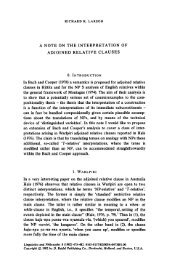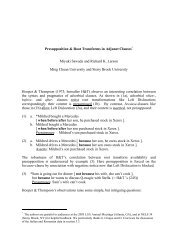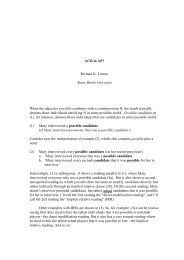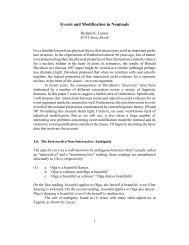Intensional Transitive Verbs and Abstract Clausal Complementation
Intensional Transitive Verbs and Abstract Clausal Complementation
Intensional Transitive Verbs and Abstract Clausal Complementation
Create successful ePaper yourself
Turn your PDF publications into a flip-book with our unique Google optimized e-Paper software.
<strong>Intensional</strong> <strong>Transitive</strong> <strong>Verbs</strong> <strong>and</strong> <strong>Abstract</strong> <strong>Clausal</strong> <strong>Complementation</strong><br />
Consider now the parallel point for the pair in (80). With the latter there is complement VP<br />
movement at LF, with the object each comic book moving into Agr o Spec (81). The object thus raises into<br />
the matrix clause:<br />
(80) a. I am seeking to find each comic book.<br />
b. I am seeking each comic book.<br />
(81) I am [ AgroP each comic book looking-for-FIND [ CP [ VP t ] [ C’ t [ AgrsP PRO t ]]]]<br />
As in the ECM cases, we expect A-raising to preserve the downstairs construal, but ceteris paribus we<br />
also expect the same general enhancement of wide scope de re construal found in the ECM case. Thus<br />
we account for the differential scope preferences identified by Zimmermann (1993). 37<br />
5.0 Concealed ECM Complements (imagine, picture)<br />
<strong>Intensional</strong> transitives of volition <strong>and</strong> search are analyzed here as restructuring constructions, parallel to<br />
what one finds in Romance languages. A different analysis holds, we believe, for the class of intensional<br />
transitive verbs including imagine, picture, paint <strong>and</strong> expect in one of its syntactic realizations (see below).<br />
These verbs do not take control complements, but rather select a small clause (82a-c), or an ECM<br />
infinitive (82c): 38<br />
(82) a. i. Max imagined a new car.<br />
ii. Max imagined [a new car in his driveway]<br />
b. i. Max pictured a unicorn.<br />
ii. Max pictured [a unicorn in his yard]<br />
37 An interesting question is raised for our analysis by the fact that quantified subjects of want-type verbs do not<br />
routinely show the same scopal possibilities as quantified subjects of believe-type verbs, even when the<br />
complementizer for is absent. Thus construal of every defendant with wide scope appears to be more difficult in (ia)<br />
than in (ii) (<strong>and</strong> certainly more difficult in (ib)). This appears mysterious if both involve LF raising to Agr o :<br />
(i) a. Some juror wants every defendant to be acquitted.<br />
b. Some juror wants for every defendant to be acquitted.<br />
(ii) Some juror believes every defendant to be guilty.<br />
However, despite the fact that both (ia) <strong>and</strong> (ii) involve raising in our analysis, there is an important difference<br />
between (ia) <strong>and</strong> (ii). With believe, the subject raises to Spec Agr o from a non-Case position, whereas with want the<br />
subject raises from a position where light Nominative Case is checked. As is shown by infinitival relative<br />
constructions (A man OP i t i to mow the lawn) light Nominative Case is sufficient to license a variable. The upshot is<br />
that in (ia), the quantifier every defendant will (after deletion of intermediate traces) be bound to an A-position in<br />
which Case-is checked (a variable position), whereas in (ii) every defendant will be bound to an A-position in which<br />
Case-is not checked. We suggest that this is the source of the difference in readings. With respect to scope, (ia)<br />
(after deletion of intermediate traces) basically behaves like a QR structure, where the quantifier moves from a Case-<br />
position. By contrast, (ii) maintains the status of a raising construction.<br />
38 Forbes (1997b) takes verbs of the imagining-picturing class as presenting a special challenge for propositional<br />
analyses of intensional transitives. This view appears to be based on an incomplete appreciation of the possibilities<br />
for clausal complements in natural language, which includes small clauses.<br />
31



